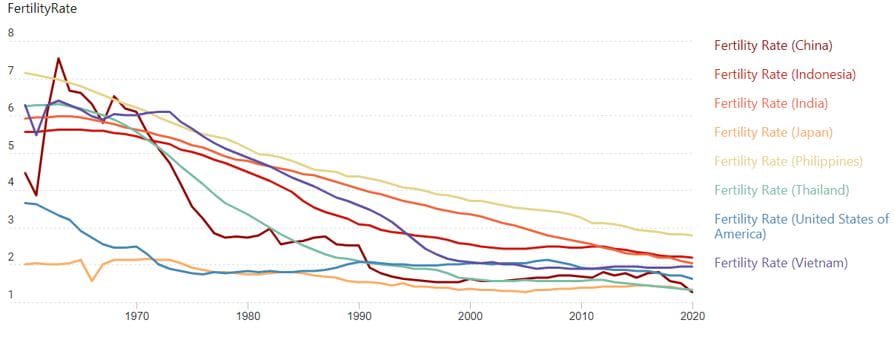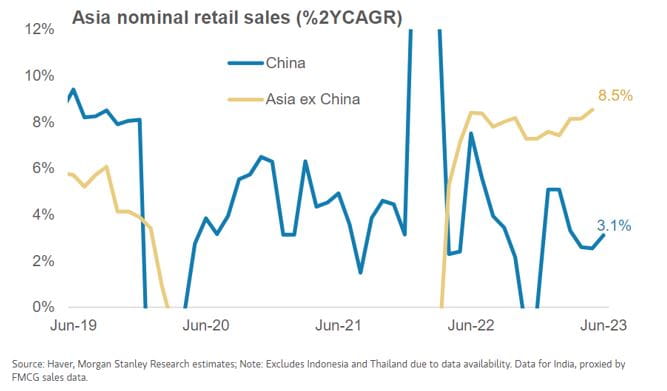At GAM Investments, our purpose is to protect and enhance our clients’ financial future. As part of this, we are constantly challenging ourselves to think beyond the obvious. In the Thematic Thoughts series, we highlight emerging sustainability ideas and themes that could present investment opportunities.
08 September 2023
The challenge we face
In an increasingly multipolar world, there is one driver that is unquestionably dominating the East: a thriving and diverse population of 4.3 billion1.
Asia makes up 30% of Earth’s land area, yet is home to 60% of the global population. This creates impactful opportunities, ranging from increased productivity to improved financial inclusion, alongside challenges such as rising resource constraints and waste generation.
Given the vast diversity between countries across the region, from both an economic and social perspective, there is no ‘one size fits all’ solution for sustained and accountable economic growth.
Why does this matter?
The long-standing debate regarding exponential population growth and rising fears on how this will continue to push planetary boundaries is ongoing. However, evidence behind approaching peak population is mounting, primarily due to rapidly declining fertility rates in the East.
Using US fertility rates as a yardstick, where the average female experiences 1.64 live births during her reproductive years, major economies in Asia, covering 1.6 billion people across China, Japan and Thailand, already fall well below this reproductive rate.
When it comes to other countries across the region, trends tend to be more diverse. Indonesia’s fertility rate currently stands at 2.19 and has moved in line with economic activity. The opposite can be said of India, where fertility rates have declined to 2.05 as the country grows richer.
Chart 1: Fertility rates by country

With India surpassing China as the world’s most populous country with over 1.4 billion people, of which over half the population is aged under 30, the growth potential over the coming decade is not one to ignore; neither are the unintended consequences of this structural theme.
Following a summer of record temperatures and a delayed monsoon season, which sent the price of essential crops such as rice (+21% year-to-date) and tomatoes (+435% quarter-on-quarter) soaring and led to export controls, sustainable development is front of mind.
India is hosting this year’s G20 Presidency under the theme “Vasudhaiva Kutumbakam” or “One Earth, One Family, One Future”, focusing on the value and interconnectedness of all life on Earth. With emissions per capita remaining highly divergent between Asia ex. China versus the US and Europe, discussions around fossil fuel reduction and financing for developing nations continues to be a sticking point going into COP28 in December 2023.
These challenges bring opportunities; alongside robust GDP numbers coming out of Southeast Asia this year, signs of peaking rates and the rapid expansion of supply chains across the region driven by geopolitical tensions, the investment case appears promising.
What is the opportunity from an investment perspective?
The fundamental second order effect of a large and emerging population base is a self-enforcing shift in consumerism ranging from basic goods for survival such as air conditioning units and toilets to electric two wheelers to luxury goods and travel services driven by aspirational spenders. Recent studies from McKinsey expect a consumerism drive valued at USD 10 trillion from Asia alone over the next decade and despite persistent headline inflation in the short term, this trend appears to be holding up well in Asia ex. China and broadening to rural consumers.
Chart 2: Asia nominal retail sales (2Y CAGR)

A key observation to note is not only what goods and services are purchased, but how they are purchased. Asians are increasingly accustomed to using and relying on technology platforms, given the seamless experience and recurring purchase incentives offered by apps such as TikTok, Zomato and Shopee.
The drive to transition from fossil fuels to renewables is a global phenomenon but Asian developing nations have the added benefit of leapfrogging development to include sustainable features from the get-go versus retrofitting existing infrastructure. This is particularly key as economic hubs and cities are planned and built out, with Indonesia and India illustrating key examples.
Indonesia is in the process of moving its sinking capital city from Jakarta on the island of Java to Nusantara, Borneo by 2024, driven by excessive groundwater extraction for its overpopulated 30 million residents, rising sea levels as well as unbearable pollution. The vision of a futuristic metropolis is creating demand for contractors to house 1.5 million civil servants, electric buses to ferry an estimated resident population of 2 million and biodiversity consulting services to advise on the industrial forest plantations surrounding the growing city and counter pulp-driven deforestation.
Although dwarfed by the US Inflation Reduction Act’s production-linked support estimated at USD 390 billion, India has conveyed similar incentives amounting to USD 8 billion and covering solar module manufacturing, battery storage and green hydrogen. The pace of the initial build out phase of hydrogen-related infrastructure, meeting both increasing domestic energy needs as well as exports, is highly dependent on global technology advancements. Electrolyser cost deflation is primarily driven by design efficiencies and diminishing reliance on rare earth materials, enabling European and US technologies to diffuse into India and Southeast Asia to deliver lower production costs and a greater uptake of green hydrogen.
From a social perspective, digitalisation has enabled a step change improvement in financial inclusion and independence, driven by governments and the emergence of fintech players gaining popularity during Covid-19 lockdowns. Findings from the Global Findex Database demonstrate increasing use of digital payments in developing countries, with the participation rate growing from 35% in 2014 to 57% in 2021. A key enabler to improving financial access is fractionalisation, where transactions are divided into smaller quantities, which is already being seen within the payments, insurance and alternative investments space across the region.
When it comes to managing a large and dispersed population, a solid digital strategy at a governmental level is vital. This is particularly evident with the public-private partnership developments of the India Stack, the ambitious project of creating a unified software platform to bring India's population into the digital age. Starting with the biometric identification system Aadhaar, established over 10 years ago and registering over 1.3 billion people, the Modi government has rolled out a series of digital systems enabling payments, government transactions, health records and document storage. Digital payments are underpinned by the Unified Payments Interface (UPI) and supported by over 350 domestic and global banks, rapidly growing to become the world’s fifth largest digital payment network by volume. Not only does this bring small businesses online, it also opens up opportunities for private e-commerce players in the market. Uptake of the UPI network is driven by smartphone penetration, which is currently at around 60%, and access to a reliable and affordable internet connection made possible by the likes of Jio by Reliance Industries.
These are just a few examples of the many opportunities springing up across the region that will enable a large and growing proportion of the world’s population to access clean and affordable energy and vital financial products that could provide a safety net, enabling families from low to middle incomes a chance to spend increasing wealth on newfound luxuries underpinned by a more sustainable economy.
The information contained herein is given for information purposes only and does not qualify as investment advice. Opinions and assessments contained herein may change and reflect the point of view of GAM in the current economic environment. No liability shall be accepted for the accuracy and completeness of the information contained herein. Past performance is no indicator of current or future trends. The mentioned financial instruments are provided for illustrative purposes only and shall not be considered as a direct offering, investment recommendation or investment advice or an invitation to invest in any GAM product or strategy. Reference to a security is not a recommendation to buy or sell that security. The securities listed were selected from the universe of securities covered by the portfolio managers to assist the reader in better understanding the themes presented. The securities included are not necessarily held by any portfolio nor represent any recommendations by the portfolio managers nor a guarantee that objectives will be realized.
This material contains forward-looking statements relating to the objectives, opportunities, and the future performance of the U.S. market generally. Forward-looking statements may be identified by the use of such words as; “believe,” “expect,” “anticipate,” “should,” “planned,” “estimated,” “potential” and other similar terms. Examples of forward-looking statements include, but are not limited to, estimates with respect to financial condition, results of operations, and success or lack of success of any particular investment strategy. All are subject to various factors, including, but not limited to general and local economic conditions, changing levels of competition within certain industries and markets, changes in interest rates, changes in legislation or regulation, and other economic, competitive, governmental, regulatory and technological factors affecting a portfolio’s operations that could cause actual results to differ materially from projected results. Such statements are forward-looking in nature and involve a number of known and unknown risks, uncertainties and other factors, and accordingly, actual results may differ materially from those reflected or contemplated in such forward-looking statements. Prospective investors are cautioned not to place undue reliance on any forward-looking statements or examples. None of GAM or any of its affiliates or principals nor any other individual or entity assumes any obligation to update any forward-looking statements as a result of new information, subsequent events or any other circumstances. All statements made herein speak only as of the date that they were made.